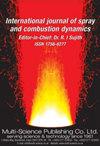On the convective wave equation for the investigation of combustor stability using FEM-methods
IF 2.1
4区 工程技术
Q3 ENGINEERING, MECHANICAL
International Journal of Spray and Combustion Dynamics
Pub Date : 2022-03-01
DOI:10.1177/17568277221084470
引用次数: 0
Abstract
Solving the Helmholtz equation with spatially resolved finite element method (FEM) approaches is a well-established and cost-efficient methodology to numerically predict thermoacoustic instabilities. With the implied zero Mach number assumption all interaction mechanisms between acoustics and the mean flow velocity including the advection of acoustic waves are neglected. Incorporating these mechanisms requires higher-order approaches that come at massively increased computational cost. A tradeoff might be the convective wave equation in frequency domain, which covers the advection of waves and comes at equivalent cost as the Helmholtz equation. However, with this equation only being valid for uniform mean flow velocities it is normally not applicable to combustion processes. The present paper strives for analyzing the introduced errors when applying the convective wave equation to thermoacoustic stability analyses. Therefore, an acoustically consistent, inhomogeneous convective wave equation is derived first. Similar to Lighthill’s analogy, terms describing the interaction between acoustics and non-uniform mean flows are considered as sources. For the use with FEM approaches, a complete framework of the equation in weak formulation is provided. This includes suitable impedance boundary conditions and a transfer matrix coupling procedure. In a modal stability analysis of an industrial gas turbine combustion chamber, the homogeneous wave equation in frequency domain is subsequently compared to the Helmholtz equation and the consistent Acoustic Perturbation Equations (APE). The impact of selected source terms on the solution is investigated. Finally, a methodology using the convective wave equation in frequency domain with vanishing source terms in arbitrary mean flow fields is presented.用有限元法研究燃烧室稳定性的对流波动方程
利用空间解析有限元方法求解亥姆霍兹方程是一种行之有效且经济有效的热声不稳定性数值预测方法。在隐含的零马赫数假设下,忽略了声学与包括声波平流在内的平均流速的相互作用机制。整合这些机制需要高阶方法,而这需要大量增加计算成本。一个折衷可能是频域的对流波动方程,它涵盖了波的平流,并且与亥姆霍兹方程的代价相当。然而,由于该方程仅适用于均匀平均流速,因此通常不适用于燃烧过程。本文力图分析对流波动方程在热声稳定性分析中引入的误差。因此,首先推导出一个声学上一致的非齐次对流波动方程。与Lighthill的类比类似,描述声学和非均匀平均流之间相互作用的术语被视为源。为了应用有限元法,给出了弱形式方程的完整框架。这包括合适的阻抗边界条件和传递矩阵耦合程序。在工业燃气轮机燃烧室模态稳定性分析中,将频率域的齐次波动方程与亥姆霍兹方程和一致声摄动方程进行了比较。研究了所选源项对解的影响。最后,提出了一种在任意平均流场中使用源项消失的频域对流波动方程的方法。
本文章由计算机程序翻译,如有差异,请以英文原文为准。
求助全文
约1分钟内获得全文
求助全文
来源期刊

International Journal of Spray and Combustion Dynamics
THERMODYNAMICS-ENGINEERING, MECHANICAL
CiteScore
2.20
自引率
12.50%
发文量
21
审稿时长
>12 weeks
期刊介绍:
International Journal of Spray and Combustion Dynamics is a peer-reviewed open access journal on fundamental and applied research in combustion and spray dynamics. Fundamental topics include advances in understanding unsteady combustion, combustion instability and noise, flame-acoustic interaction and its active and passive control, duct acoustics...
 求助内容:
求助内容: 应助结果提醒方式:
应助结果提醒方式:


